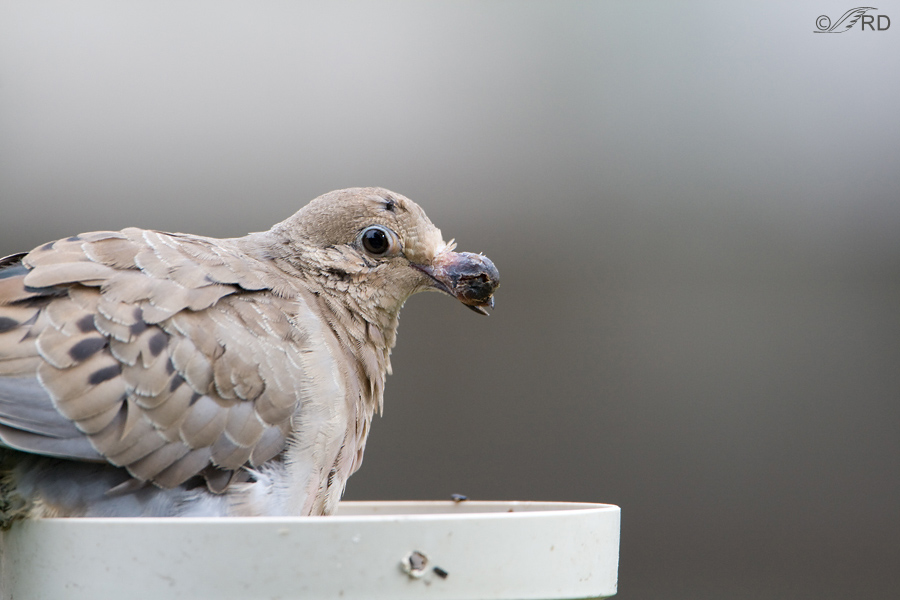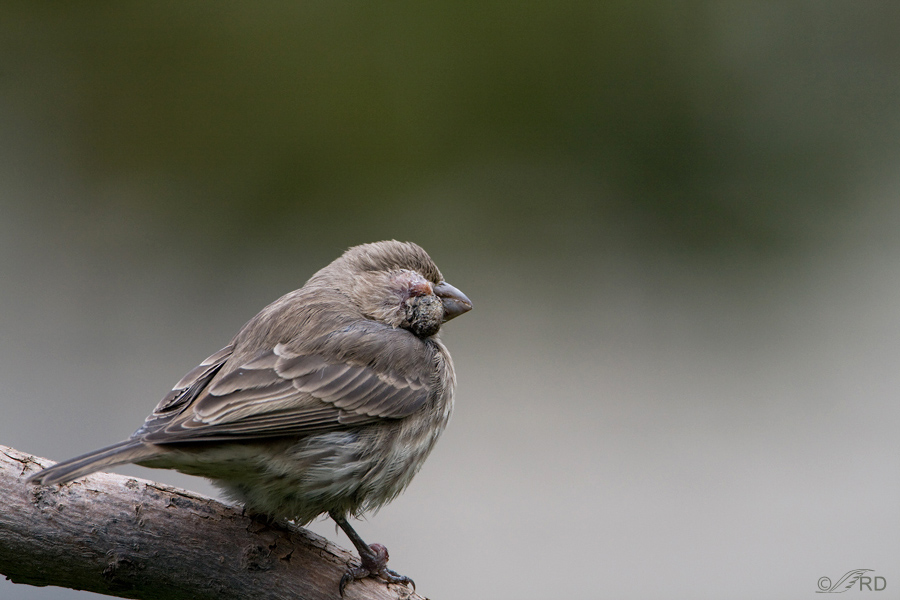Several years ago when I was new to bird photography I would often practice photographing the several species of birds that would come to my back yard feeder in order to improve my skills. Later that summer I began to notice birds with deformities, especially on or near their bills, eyes, legs and feet. At first I thought they were some kind of tumors but on the morning I took these shots I saw three birds (two House Finches and one Mourning Dove) that were affected so I became alarmed and took the photos to the vertebrate disease specialist at Division of Wildlife Resources here in Salt Lake City. The diagnosis was avian pox.
Mourning Dove with avian pox growths on bill
Avian pox is a serious disease of many species of birds caused by several strains of avipoxvirus. The most common form, cutaneous pox, causes wart-like growths around eyes, beak, legs or any unfeathered skin. Those warts may interfere with feeding, sight, breathing or perching. Affected birds often become emaciated due to the inability to feed. Avian pox causes significant mortality in infected birds but they often recover as long as they’re able to feed. There is no evidence that avipoxvirus affects humans.
Same bird, right side view
Birds become infected with the virus through direct physical contact with infected birds, ingestion of food or water contaminated by other infected birds or through contact with contaminated surfaces – especially at bird feeders and perches. The virus enters through skin surfaces that have become abraded (which is why only unfeathered skin gets the lesions). Mosquitoes also act as vectors of the virus.
House Finch with avian pox warts on foot
The avian pox on this finch’s foot comes from warts on only a single toe. The bird’s behavior didn’t seem to be affected by the warts and it foraged normally. You can see that it chose to rest standing on the infected foot with the other one drawn up to its belly.
House Finch with avian pox warts on eye and lower leg.
The warts on the eye of this finch completely blinded it on that side but it was simply amazing how well it compensated for the affliction. It flew and even landed normally but it was obvious that it was blind on the right side because I could walk right up to it until it turned its head.
I photographed all three of these birds within a 15 minute span so I knew there was a serious problem in my neighborhood and after my visit to the vertebrate disease specialist and some further research I realized that bird feeders in my neighborhood (there were many of them, including mine) may have contributed to this disease outbreak. In order to prevent the spread of this disease experts recommend keeping feeders clean and regularly washed with a 10% bleach solution.
It’s my gut feeling that backyard feeders have a more positive effect on bird populations (by far) than any negatives caused by the occasional spread of disease that may be enabled by close contact with lots of birds at feeders. That said, preparing this post has reminded me once again just how important it is to keep my feeder clean!
Ron
***Note: My apologies for the relatively poor quality of these photos (processing, composition etc). They were taken and processed when I was mostly lacking in photography and processing skills and sadly I must have deleted the original files.






Avian pox seems to be what’s sickening several of the young house finches in my area: metro-Denver, Colorado. A small percentage of the flock, but it makes them weak and unable to fly. So far, no other type birds are affected. I will increase the frequency of cleaning the bird-feeders and area, and will stop feeding for a week. This will confuse them, but slowing the disease-spread is good. They look so pitiful. Thanks for the info.
Last year it was conjunctivitis and the Gold Finches…this year it appears to be Avion Pox,but this time it’s the Red Sparrows that seem to be mostly affected.. I have mostly sock feeders that feed over 300 Gold Finches a day.i go through 100 lbs. of Niger seed a week. I always clean and disinfect the socks every 4 or 5 days and water bowls every day,but still having sick birds. So I removed all food for 10 days kept the water though. It’s just to hot now to take away their water when I know they will be forced to drink gutter and swimming pool water. So I bleach the glass bowls twice a day and put Grapefruit Seed Extract in each bowl. It is natures antibiotic and will not hurt them. I’ve noticed
No more casualties ,but I haven’t put the seeds back… July August are not good months to take food away…so many babies. Also other people feed birds and have taken offense when I asked them to join me in trying to wipe out this
In our area,or stop feeding them all together…No cooperation was received.. So if there are any suggestions ? I would appreciate it.
I have MS and stay home . So I started this to keep me busy and to improve the quality of life for our wild bird population in LA. I started with one feeder and about 20 pale barely yellow Gold Finches to now over 300 vibrant,healthy
Finches. Their yellows are so bright,they all are so much healthier and are living longer.
I live in Las Vegas, NV and have noticed about four of my wild house finches with what looks like tumors on them. Two of the little new babies who are getting fed by the parent have tumors directly on the upper beak, one of the babies (who is also being fed by a parent has a tumor on what looks like its cheek below the eye and one of them has the tumor on its feet. These sweet little birds are at the bird feeder every day all day long. What should I do? Any advise?
Brigitte, It sounds to me like avian pox. It’s quite contagious which would explain why the fledglings have it. It’s my understanding that some birds survive it and some don’t – largely based on how it affects their vision and feeding abilities. My advice would be to clean your feeders with bleach as it often spreads at feeders (cleaning instructions and bleach concentrations can be found online). Good luck.
Recently a House Finch has showed up in my yard with worts on its beak. It is the only bird so far I have seen with the warts. Who can I contact to report the sighting. I do have pictures of the bird.
Jean, I took my photos of the diseased birds to the Vertebrate Disease Specialist at the Department of Natural Resources. She was very interested and asked to keep copies of the images.
I participated, for a time, in the Cornell House Finch Disease reporting survey. I never saw house finches at my feeders with any visible indication of disease, but my feed population dropped of quite dramatically over the course of the study.
Katie, I still see the occasional finch or dove with symptoms similar to this but thankfully it’s become a rare occasion.
Is it possible for a human with a vulgaris / hand wart to spread a wart to a pet bird, like a cockateil?
I strongly doubt it Fred but I don’t know for sure.
I thought I had commented here, but perhaps not. Obviously not. In Australia our cockatoos are open to a truly nasty disease called Beak and Feathers. Their beaks keep growing to the point that they can no longer eat or drink. Their plumage is also affected because they can no longer groom themselves. They often wind up bald with deformed beaks – a slow and nasty death. Their is as yet no treatment. It seems to be spread in much the same way as Avian Pox. We are careful with our feeder which is cleaned and disinfected regularly but there are a lot of people feeding birds …
Elephant’s Child – Beak and feathers sounds like a devastating disease – somewhat similar to our Longbilled Hawk Syndrome. https://featheredphotography.com/blog/2011/11/06/red-tailed-hawk-with-long-billed-hawk-syndrome/
Thanks for the post Ron, and the reminder to clean the feeders when I get home.
Very insightful post. I didn’t know about Avian Pox.
I’ve never even heard of Avian Pox. It’s an incredible looking disease. How unfortunate. Hey, thanks for teaching me something today! haha.